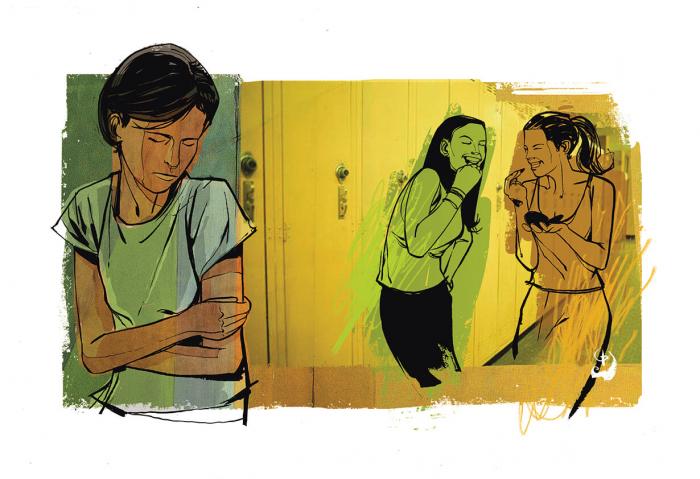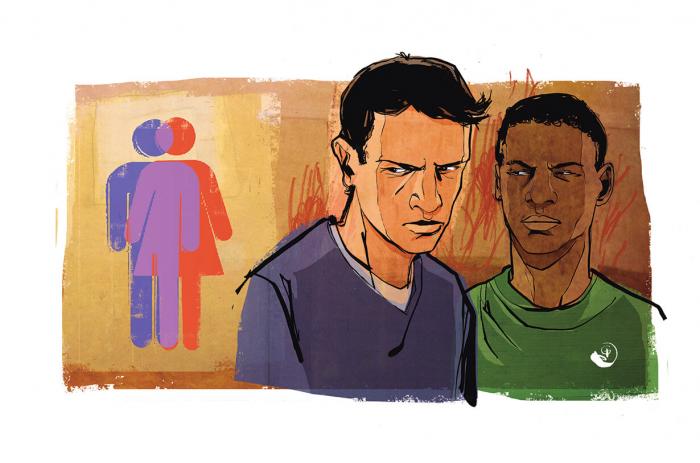John S. left behind more than most students when he graduated from high school last year.
Aside from saying goodbye to friends and familiar surroundings, he left behind his birth name of Caroline and many of the daily indignities he faced as a transgender student at a high school in upstate New York.
The stares and jokes in the locker room. The sneaking into bathrooms when no one else was around. The teachers who either refused or forgot to call him John instead of Caroline. And a school administration he says not only misunderstood his needs but also failed to try.
John was more than ready to leave all that behind. He skipped a grade and completed the mandatory graduation requirements early, earning his high school diploma a full year ahead of schedule.
Now, the 17-year-old freshman at the University of Rochester says he finally is on his way to gaining what he's yearned for as long as he can remember: the freedom to live on the outside as he's always felt on the inside, without ridicule and without shame.
"It's easier now. The facilities are more androgynous; there are co-ed sleeping arrangements and co-ed baths. I don't have to make those choices so much, about whether to go in the boys' room or the girls' room," John said. "I finally have this sense of self-discovery and freedom, and I'm beginning to feel more confident and more self-assured."
John's road has been a long one. "I always felt different, even as a very little kid," he said. "I never wanted to do anything that said, 'I'm a girl,' or 'This is what girls do.'" At age 9, he refused to wear the dresses or skirts his parents purchased for him. By the time he reached middle school, he had come to terms with the fact that his inward feelings and outward gender did not match.
As a high school student, John dressed as a boy and introduced himself to classmates as a boy but felt anything but confident and self-assured.
"I would go in the girls locker room to change for gym class, and I felt intensely uncomfortable. A lot of the girls would stare or say rude things. Or sometimes, I'd walk in, and they'd stop what they were doing and leave," John recalled. "Then, when I would go in the guys locker room, which is where I felt like I belonged, I got kicked out."
Going to the restroom was just as uncomfortable: "I just tried not to go during school hours. Or I'd peek around the corner, look under the stalls to see if I was by myself and go when nobody else was there."
Unwelcome and unsafe
John's experiences are not unlike those of many transgender students in schools across the nation.
"A lot of the day-to-day activities of basic life existence are things most people take for granted — basic things like where to (go to the bathroom)," said Jessie Gilliam, program manager for gay, lesbian, bisexual and transgender initiatives at Advocates for Youth. "But if you are transgender, you think about those things every minute."
In addition to lacking specific protections against transgender harassment, Gilliam says many schools have policies that negatively impact transgender students.
"Dress code rules come to mind," Gilliam said. "These ways of enforcing gender presentation, like a girl can't come to prom or graduation dressed in male clothing or vice versa. These things create an unwelcome climate for transgender students."
More than just unwelcome, statistics show that for many transgender students, school also can be unsafe.
The 2003 School Climate Survey, conducted by the Gay, Lesbian and Straight Education Network, shows that more than 25 percent of transgender students reported experiencing verbal or physical harassment because of their gender expression. The survey also shows that more than 80 percent of transgender students reported experiencing sexual harassment because of their gender expression.
John said he found some solace from his school's gay-straight alliance, but he believes the group was not fully supported by school administrators.
"Our GSA was small but active. Outside of the GSA, nobody really liked it. Our posters and fliers would get trashed, and nothing was done about it," John said. "To make things worse, we'd have to go to these mandatory assemblies for other school groups and clubs, to learn more about them, but nobody did that for us — and they didn't have to."
Many schools are just barely beginning to address the needs of gay and lesbian students, said Vanessa Edwards Foster, chair and cofounder of the National Transgender Advocacy Coalition (NTAC). The gender issue, she said, brings a whole new dynamic.
"It poses a problem that doesn't present itself with other students dealing with sexual orientation," Foster said. "The overwhelming majority of schools aren't even addressing this issue at all."
Ahead of the curve
One school district in New York finds itself ahead of the curve when it comes to meeting the needs of transgender students. The Rochester School Board added language protecting transgender students from harassment and discrimination to its student and employee code of conduct in December 2003.
The adoption of protections for transgender students was one of four recommendations made by a districtwide task force created to assess safety and climate issues for LGBTQ students and faculty. Other recommendations from the task force included the adoption of domestic partner benefits, a policy statement in the staff handbook underscoring the philosophy that diversity includes issues of sexual orientation and gender identity, and the availability of professional development to raise awareness about issues gender identity and sexual orientation. Those recommendations have not yet been adopted.
"We felt the district needed to model the behavior it wanted to see from students," said James Bowers, chair of the Rochester School Board and the district-wide task force. Bowers said the addition to the code of conduct was the first step in an ongoing process. Professional development, he said, is vital to creating sustained change in school climate.
"We are just dealing with the harder part of this process now," said Bowers, who also is a professor of political science at St. John Fisher College. "The harder part is seeing the implementation of our recommendations through, and ensuring that teachers and administrators accept gender identity as defined by a student. Education is an important part of the process."
Earlier signs, younger students
Dealing with gender non-conformity is even more difficult in earlier grades, according to Foster of NTAC. With more students exhibiting gender identity issues at younger ages, many schools find themselves dealing with uncharted territory.
That territory is something Lauren Mattone, a kindergarten teacher in Amherst, Mass., learned about firsthand. When "Celia," a student in her class presented herself as a boy, other students were confused and preoccupied.
"In the beginning, the girls complained a lot, and some of the kids were really frantic," Mattone said. "They'd come to me, and they'd tell me how she looked like a boy and acted like a boy, but she really was a girl."
Mattone said she talked with her class a great deal about what "acting like a boy" or "acting like a girl" meant.
Like Gilliam of Advocates for Youth, Mattone believes many preconceived notions about gender and gender identity take root in schools and classrooms.
"We require kids to look a certain way, we tell girls how they are supposed to dress and boys how they are supposed to dress, and we enforce these rules based on gender," Mattone said. "What Celia needed was for someone to go to bat for her, someone to say, 'She has to be able to wear that baseball cap.' Too often, kids don't get the support from adults that they should."
Though Celia is no longer in her class, Mattone said she has continued to mentor her former student. She knows that as Celia gets older and continues to identify as a boy, things likely will become more difficult for her.
A child's right
Foster said in cases of younger children who exhibit gender non-conformity, society often blames and questions parents about what they may or may not be doing to promote the behavior.
"In elementary schools especially, it may be much more difficult for parents to convince administrators that this is their child's right," Foster said. "There have even been cases where schools have requested young students be home-schooled because of a gender issue."
Elizabeth Bauchner, a freelance writer in New York, said she feels fortunate that her 6-year-old son, Adrian, has had teachers who are supportive and understanding. Since about age 3, Adrian has loved to wear dresses and frilly, sparkly clothing.
"We'd go shopping and see pink and purple things, and play make-up, and those things appealed to him more than anything else," Bauchner said. "He would tell me that he wished he was a girl, and that he wanted to be a girl."
The preschool teachers at the parent-cooperative school Adrian attended never made Bauchner or her son feel this behavior was wrong or abnormal.
Adrian, who began 1st grade this year, is no longer wearing dresses to school. But he is growing his hair long and carries a floral lunchbox.
Bauchner said she has never "stressed out" about Adrian's behavior.
"If he is transgender, or turns out to be, it just really doesn't matter," she said. "I think his life would be hard, because of other people's prejudices, but I'm going to love him no matter who he is or what he does."
Education, support are key
Parents like Bauchner and teachers like Mattone, according to Foster of NTAC, are "far and away the exception and not the rule."
"Rather than deal with these issues proactively, many schools stifle transgender students with prohibitive and uninclusive policies," Foster said. "Then a lot of parents have a difficult time dealing with sexual orientation or gender identity, wanting to believe it's just a phase."
Advocates outline specific recommendations for schools to support transgender students, including providing gender-appropriate restroom accessibility, using names and pronouns in accordance with student identification, and implementing dress codes that allow students to dress according to gender identity.
Chief among all recommendations, Foster said, is increased education.
"Schools need to be educated on the subject, and be open-minded, and think outside the box," Foster said. "Right now, there is a lack of education along with prejudice and laziness. Too many schools don't want to bother to address the issue."
Bowers of the Rochester School Board said it is important for school board members to get involved. "It just takes one or two members who are willing to show political courage, to push the issue and do it consistently," said Bowers. "The role of a school board is so much broader than delivering textbooks and voting on a budget."
Supporting gay-straight alliances in schools is important, too.
"Schools need to understand the establishment of a GSA is not going to undermine the moral fabric of their school," Bowers said. "These groups provide necessary support to gay, lesbian, bisexual and transgender students. From the superintendent and school board on down, it has to be made clear that where there is an interest in forming these groups, school administrations will not impede that process in any way."
Real change will come from students and parents demanding all students be treated equitably, as human beings, regardless of gender identity.
For now, John S. is doing his part to further the education process, with his parents and on his university campus.
"I keep giving my mom informational pamphlets and materials, to help her understand this better," said John, who also has joined a gay, lesbian, bisexual and transgender advocacy group on campus.
"We have to get it out in the open, and talk about this at an earlier age. Had that happened for me, I think I'd be farther along in this process," John said. "Maybe rather than just now feeling confident and OK with feeling like a boy, I would be on my way to feeling like a man."
Gender Exploration at Preschool: A Process for Self-Discovery
During my son's preschool years, he preferred to wear dresses and tights over pants; pink and purple clothing rather than blue or gray; and his red bikini instead of boys' swim trunks. He liked wearing girls' clothing so much that he almost never put on his jeans or "boy" clothes unless we were going to a family event or place that would not have been accepting of his choices.
While his choice of clothes caused some concern for the grandparents, the one place he felt truly safe and free was his nursery school. My son attended UCNS, a parent cooperative, in Ithaca, N.Y., for two years. He would often arrive in his purple dress with black flowers or, if he wasn't wearing a dress when he arrived, he would head straight for the dress up corner where he would put on a red dress with long sleeves and a zipper in the back. Then he would look for a pair of play high heels, either the ones with purple leopard print or the ones with fake fur.
His teachers, Jayne Kemp and Jaime Jacobs-Rossfeld, neither encouraged nor discouraged my son's choice of clothing. Kemp, with more than 30 years of early childhood education experience, believes that young children don't have notions of gender like adults do. "Children don't come with pre-conceived notions of gender," she said in a recent interview. "It's all in how the adults handle it."
Kemp's philosophy on gender identity at the preschool level follows her general philosophy on children: They learn about themselves and their world through play, and their needs must be met and not denied by the adults in their lives. When their needs are met, Kemp believes, they move on to the next stage of development. When their needs aren't met, they don't go away, but become suppressed by the child and will find other ways of being expressed.
As for my son, Kemp believes that he has a real need to wear the clothes he does. For one, he likes dresses because he thinks they are more comfortable, and for another, he likes the colors pink, purple and light yellow, and unfortunately, clothing manufacturers only make girls' clothing in those colors.
At UCNS however, the dress-up area was never labeled as "girl" or "boy." Indeed, no play area was labeled with any kind of gender definition. This all helped my son process the other comments he was picking up from friends and family outside of school.
Luckily, Kemp says that no child ever commented on my son's choice of clothing, but if someone had, she would have handled it by asking the children a few simple questions in order to help them process their ideas.
For example, if a child had teased my son by saying something like, "Boys don't wear dresses," Kemp would have asked my son why he likes the red dress. Then she would have asked the other child why my son shouldn't wear the dress. In order to help the children work through the situation, she would say, "Adrian likes the red dress, and at this school you can wear whatever you want. You don't like the red dress, so you don't have to wear it."
Kemp says that using the child's name is one of the best things a teacher can do. Kids often wonder why someone eats or doesn't eat a particular food, or wears or doesn't wear a particular kind of clothing. Kemp responds matter-of-factly to these types of inquiries, "Jill's eating those grapes because that's what Jill likes to eat."
Questions about gender are handled equally as matter-of-factly. Kemp says, "It's really about valuing differences, and it needs to start here, in the early childhood classroom."
The effect this had on my son has been comfort with his own body, happiness that he is loved for who he is and not what he wears, and increased self-esteem from not being put down or demoralized for doing something that comes naturally to him.
He is 6 now and in first grade, and he still likes to dress up in girls' clothing. I've learned a lot from Jayne Kemp, and simply tell people who ask about his clothing, "That's just what he likes to wear."
My son's experience at preschool equipped him with the confidence to do what feels right for him and the self-awareness to think through the myriad issues that have arisen from this.
He's had family members, friends and kids at elementary school point out that he's wearing a "girl's shirt" or has a "girl's lunchbox," but having already processed these types of assumptions and having come to the conclusion on his own that clothes and lunchboxes don't have a gender, he's able to say to these people, "Well, I'm a boy, and because this shirt is on me, it's a boy's shirt."




0 COMMENTS